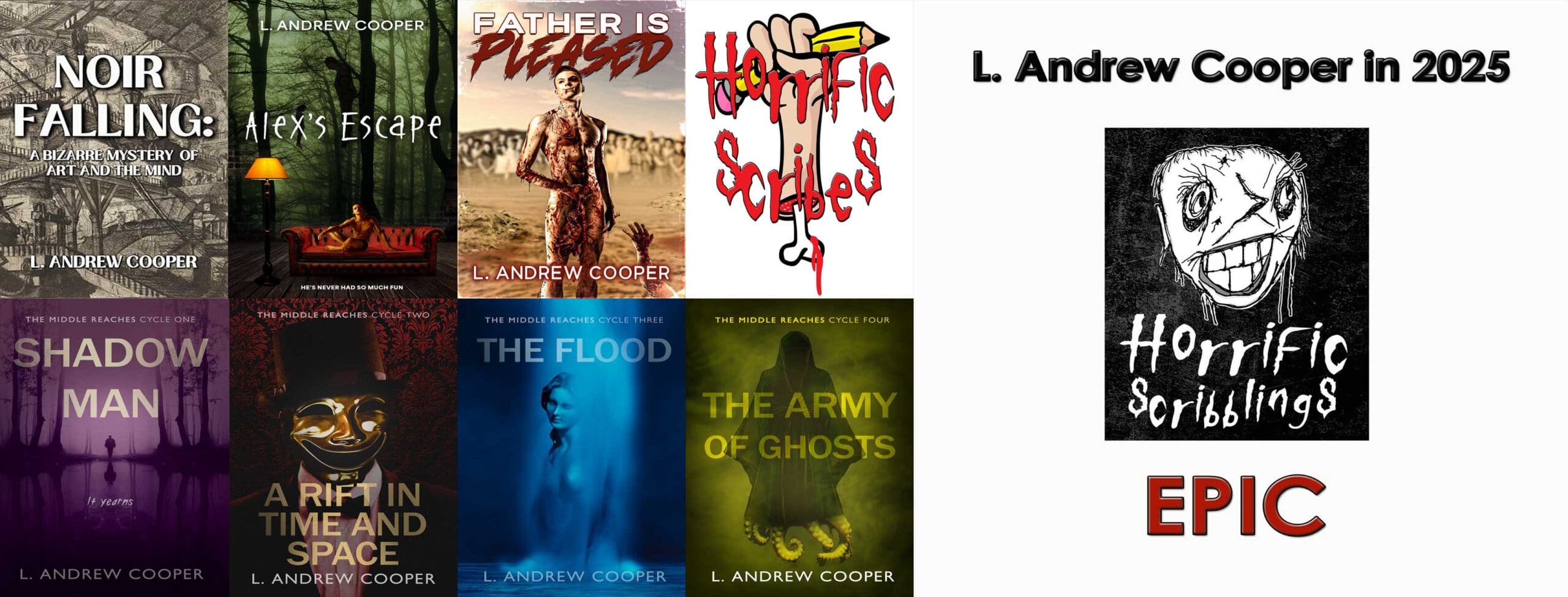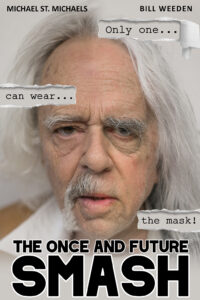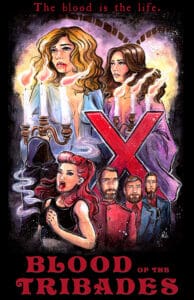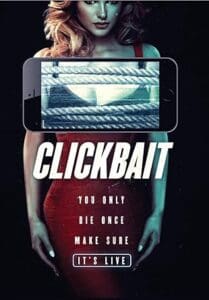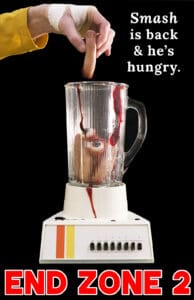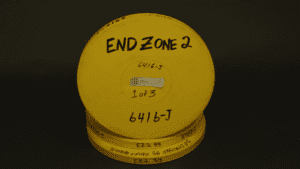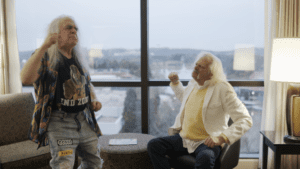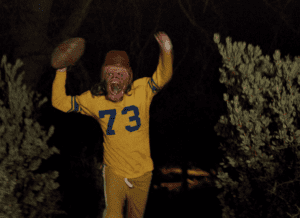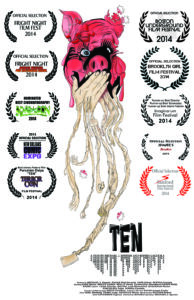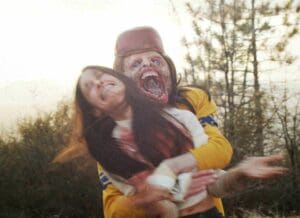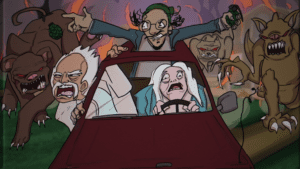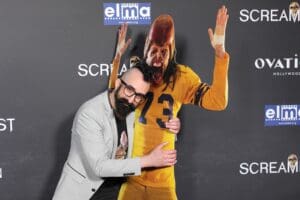Michael J. Epstein, the thoughtful, witty, and always provocative filmmaker behind darkly amusing films such as TEN, Blood of the Tribades, and Clickbait, is here to discuss his latest twist on the horror genre, mockumentary The Once and Future Smash.
The Once and Future Smash
In 1970, Mikey and William both portrayed football cannibal Smash-Mouth in the influential cult hit End Zone 2. Now, 50 years later, only one can wear the mask.
The Once and Future Smash is the story of Mikey Smash and William Mouth, who both played Smash-Mouth, the football-themed slasher character in the lost 1970 cult film End Zone 2. They are now on the convention circuit 50 years later, trying to reclaim the iconic role in the upcoming reboot sequel that starts one hour into End Zone 2.
A Launch Over and Without Your Head Film; Produced by: Sophia Cacciola / Michael J. Epstein / Neal Jones
Directed by Sophia Cacciola / Michael J. Epstein – Written by Michael J. Epstein
Starring: Michael St. Michaels (The Greasy Strangler), Bill Weeden (Sgt. Kabukiman N.Y.P.D.), A.J. Cutler
Featuring: Mark Patton (Nightmare on Elm Street 2), Laurene Landon (Maniac Cop), Richard Elfman (Forbidden Zone), Mark Torgl (Toxic Avenger), Melanie Kinnaman (Friday the 13th Part V: A New Beginning), V.C. DuPree (Friday the 13th Part VIII: Jason Takes Manhattan), Victor Miller (Friday the 13th), Marc Sheffler (Last House on the Left), Carl Solomon (Tropical Cop Tales), Adam Marcus (Jason Goes to Hell), Todd Farmer (Jason X), John Dugan (Texas Chain Saw Massacre), Bill Johnson (Texas Chainsaw Massacre 2), Bob Elmore (Texas Chainsaw Massacre 2), Lloyd Kaufman (Troma), Claudio Fragasso/Rossella Drudi (Troll 2), Tim Dry (Xtro)
The Interview
1) Ends of Influence. You actually shot the majority of End Zone 2, the film at the heart of your mockumentary The Once and Future Smash. The fictional production year for End Zone 2 (noted at the film’s beginning), 1969, has me a little stumped. While I can see influences from 60s films by the likes of H.G. Lewis and Mario Bava, as a proto-slasher—even one that supposedly influenced Wes Craven, Tobe Hooper, and John Carpenter—End Zone 2 feels like it might have come from a bit later. Why did you choose 1969? Also, the film feels like it might have been spawned from the Tarantino/Rodriguez collaboration Grindhouse (2007), distressed restoration and all. To what extent did Grindhouse, along with the renewed interest in cult horror it spawned, influence your project? Are you working from a perspective of genuine nostalgia, or do you have a more critical distance?
MJE: End Zone 2 was conceived on the intriguing idea that an obscure, previously unknown movie sparked the horror genre’s explosive growth in the 1970s and 1980s. This concept positions the film ahead of its time rather than conforming to the era’s typical style. In producing it, we were mindful to emulate that period’s shooting techniques and technological constraints.
It’s hard to say what goes on in the subconscious, and we certainly enjoyed Grindhouse, but I don’t think Grindhouse was an influence. I would say that we came to it from an almost opposite direction. Our inspiration emerged more from the culture surrounding conventions, the resurgence of interest in forgotten films, and the recognition of overlooked actors. The Once and Future Smash was our initial idea, leading us to craft a film-within-a-film that adhered to specific criteria. Our motivation stemmed not so much from nostalgia but from a fascination with how nostalgia has shaped a culture of rediscovery and celebration.
Although our film incorporates satirical elements, its core intention is to honor the allure of nostalgia and the commemoration of past performers and films rather than to satirize them. I find great joy in watching actors reengage with the convention circuit and return to acting, even though I’m not particularly interested in collecting autographs.
2) Influence 2. Maybe I’m led on by the involvement of Claudio Fragasso and Rossella Drudi, but I see a relationship between your film(s) and the films Troll 2 (1990) and Best Worst Movie (2009), the latter being a documentary about the cult following that grew up around the reputedly terrible former, a horror film (sort of). How far do you think this relationship goes? How do you feel about treating films as “camp,” as—to paraphrase Susan Sontag—especially good because they’re awful?
MJE: The concept behind Troll 2 / Best Worst Movie is similar to our approach, but I don’t think it was the primary influence. While not initially intentional, I later recognized that The Once and Future Smash might have been structurally influenced by the documentary Life After Flash. Experiencing Life After Flash and Flash Gordon back-to-back at a festival opened my eyes to a specific layered approach to storytelling. I aspired to recreate a similar experience in our film. Life After Flash intriguingly juxtaposes the grandeur of Flash Gordon with the more humble, somewhat melancholic present-day life of Sam Jones. In Smash, we aimed to parallel this by intertwining the narrative of the End Zone series with the personal stories of Mikey and William.
My appreciation for “camp” films is inherent, yet I’m not fond of deliberately creating “bad” films. I believe in approaching filmmaking with sincerity and genuine effort. A film’s merit doesn’t stem from its flaws but from its ability to entertain or provoke thought. Even films with technical shortcomings can be great if they are engaging or thought-provoking. Labeling an entertaining film as “bad” seems dismissive to me. For instance, I find Troll 2 entertaining, whereas The Room simply doesn’t resonate. In Best Worst Movie, director Fragasso attempts to explore this concept, but perhaps the language barrier hindered the full expression of his ideas. Having Fragasso and Drudi participate in our film was exciting, as I admire their unique and captivating work without a caveat of irony. Night Killer stands out as my favorite among their creations.
3) Unconventional Conventionists. A major setting of The Once and Future Smash is “Mad Monster Party,” a horror convention. I think you and I might have first met at a similar convention. What is your film’s view of such conventions and their attendees? Do you expect the culture you (perhaps lovingly) mock to embrace this film? Why or why not?
MJE: Our film is undeniably a tribute to convention culture, embracing its unique quirks and humor. While we poke fun at certain aspects of this culture, our intention is always in good spirits. This approach resonates well with convention culture fans, who have shown a great appreciation for our movies. Their understanding and enjoyment of our work is exactly what we aimed for, and seeing that connection is gratifying.
The comparisons drawn between our film and the works of Christopher Guest are incredibly flattering. While we may not quite reach the lofty standards set by Guest’s films, we’re proud to have aspired to such excellence. Just as metal enthusiasts relate to Spinal Tap, theater aficionados to Waiting for Guffman, and folk music fans to A Mighty Wind, we wanted to create a space where horror and convention enthusiasts could see a playful reflection of their passions. Our aim with Smash was to provide a fun, satirical, yet affectionate mirror for these fans to enjoy and relate to, celebrating the unique world they love so much.
4) The Ten Yard Line. Your earlier feature TEN (2014) also seems to play a bit in giallo/slasher territory (while acknowledging Agatha Christie, whose And Then There Were None, 1939, is arguably a slasher prototype in prose). What’s your attraction to this type of film?
MJE: We realized early on that End Zone 2 is somewhat of a revisit of our work in TEN. We try to make a completely different movie each time we dig into a feature, but somehow, we landed back at that style. It was kind of the necessary story to tell within the story here, so our direction felt necessary and somewhat predestined.
That said, I am glad you mentioned the idea of proto-slashers. One of my many pet peeves is the journalistic or analytical idea that slashers started with Halloween. Thirteen Women from 1932 has a group of women being murdered one by one as revenge for the mistreatment of one of their sorority sisters, and as they die, the killer crosses out their photos in the yearbook. There aren’t graphic, on-screen kills, but otherwise, you’re looking at a standard 80s slasher. There are probably films preceding that with heavy slasher elements.
This historical perspective presented a unique challenge for End Zone 2. We aimed to position it as the genre’s pioneering, most influential film, even setting it in 1970. However, as you noted, many elements in our film seem to draw from later works. If we delve deeper into film history, we’d likely find earlier movies that encompass nearly all the aspects we included in End Zone 2. This realization underscores the complexity and depth of the genre’s evolution, something we hoped to honor and play with in our film.
5) Keeping the Ball Moving. A pending sequel/reboot for the End Zone series is central to the story of The Once and Future Smash. What is the film’s attitude toward the reboot phenomenon? If there’s any difference, what is your own attitude? Older stars in your film are scrambling to get on board with the reboot, and they risk incredible awkwardness—as do many stars at conventions who cling to the glory of films decades from the past. In my experience, such stars tend to have a pretty good sense of humor about convention appearances. Is continuing to live for such glory ultimately more endearing or amusing? Perhaps both—or something else entirely?
MJE: We do pretty heavily mock the requel concept where films are made that ignore some arbitrary number of other sequels and resume the story at some seemingly random spot. Still, ultimately, I am fine with people making whatever movies make sense for them to make. I do not like the newer Halloween series, and I thought the most recent Texas Chain Saw requel was not good, but I dig Halloween H20 and Texas Chainsaw 3D.
The film’s perspective doesn’t extend beyond the humorous notion we developed: not only disregarding sequels, but ignoring part of the original film that the new sequel is based on. I found the idea of abruptly halting a movie midway and dismissing the rest quite amusing. This concept also significantly influenced the plot of Smash, focusing on the lost segment of the film and the resulting incomplete version of End Zone 2.
Witnessing the resurgence of interest in stars from past movies is truly heartwarming. It’s wonderful to see these actors recognized and appreciated, realizing their impact on audiences. This resurgence is one of the most remarkable phenomena I’ve witnessed in the entertainment industry. It struck a personal chord when I attended a packed midnight screening of a 4K restoration of Pieces. This was a film I had once rented on VHS, thinking only a handful of people knew about it. Years later, it’s meticulously restored, drawing full houses in movie theaters. This contrasts sharply with the fact that several Best Picture winners aren’t even available on Blu-ray, let alone capable of selling out screenings. This experience gave me a new perspective on what films truly resonate with people. Seeing the actors from these films embrace their legacy and celebrate with fans is incredibly gratifying and a testament to the enduring power of cult cinema.
6) Real Stars, Mock Movie. Speaking of stars, the list of people involved in The Once and Future Smash (see “Featuring” under the film’s description, above) is like a who’s who of actors and other filmmakers on the horror film convention circuit. How did you get so many great people involved? Can you share any stories about working with them? What were their reactions to the nature of your project?
MJE: The genesis of our film can be traced back to a pivotal conversation with our producer, Neal Jones. Neal, known for his “Without Your Head” podcast and extensive experience interviewing horror icons, was instrumental in bringing the project to life. After I shared the concept with him, Neal leveraged his connections to gain access to Mad Monster and agreed to join as a producer. His primary role involved reaching out to his network of former guests and friends, inviting them to participate.
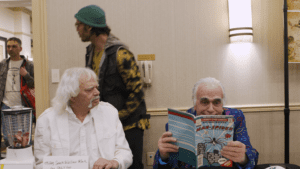
When writing the script, I didn’t know who would ultimately join the cast, so I used placeholders like “Melanie Kinnaman type” for the characters. We worked with Neal to compile a list of potential candidates we believed would fit the film well. To my surprise, many of them agreed to be part of it, largely due to their trust in Neal and trust via his reputation that the project wouldn’t portray them in a negative or ridiculous light.
While Neal arranged most of the interviews, geographical constraints meant we often conducted them without him. We provided some context to the participants, but largely, they placed their trust in us. The script included specific references and jokes about each individual’s films or careers. We made it clear that they could opt out of anything they weren’t comfortable with. Still, almost everyone embraced the entire script, enjoying the opportunity to intertwine their personal experiences with the film’s narrative.
We were extremely nervous about the interviews, but everyone we interviewed was an absolute gem to work with. We are regularly in touch with many of them and would love to work with them all again. It was an absolute honor to have them involved.
The U.S. premiere at Screamfest was particularly tense, as many interviewees were in attendance. Thankfully, everyone who saw the film expressed their love for it and pride in participating, which was a huge relief for us. Ensuring that these individuals, who trusted us, felt good about their involvement was paramount.
Many of them are doing conventions and have chosen to list The Once and Future Smash as one of their primary films in their convention profiles. For me, this recognition is one of the greatest honors imaginable.
7) Vietnam. Critics in The Once and Future Smash claim End Zone 2 reflects on the horrors of the Vietnam War, which is a common claim about iconic horror films from the 70s. To draw a parallel, how does The Once and Future Smash reflect on the horrors—or other aspects—of this moment in the 21st century?
MJE: While not directly analogous to something as historically significant as the Vietnam War, the film does delve into contemporary cultural conflicts. Observing the variety of interpretations that viewers bring to the table is fascinating. I believe that the beauty of any artistic work lies in its ability to evoke diverse perspectives and meanings unique to each individual’s experiences and viewpoints.
I’m cautious about prescribing a specific interpretation or message for the audience. I’d rather keep it an open dialogue than a didactic statement. The different interpretations I’ve seen affirm the film’s relevance across various cultural and social contexts.
8) Two Smash-Mouths? Your co-director and co-producer, Sophia Cacciola, is also your wife. How would you describe your collaboration? What different elements do you each bring to your productions? When you’re working on a project, is there a work/life balance—does work ever really stop?
MJE: We have been collaborators for about two decades, first in music and then film. We have a great way of supporting each other and dividing up projects. I do more writing, work with actors on set, and post-production. She tends to do more pre-production, production design (she made many posters and art elements for the films), cinematography, and technical management.
Our work is pretty much our life, so there is no balance. Ha!
9) Italian Style. I mentioned Mario Bava as a possible influence for End Zone 2 (I see it in the use of color and the framing of certain shots, perhaps recalling Blood and Black Lace, 1964, as a fellow proto-slasher). End Zone 2 has “rescued” Italian credits, I can see room for influence from early Dario Argento or Lucio Fulci, and The Once and Future Smash alludes to Ruggero Deodato and Umberto Lenzi. You also include Claudio Fragasso. Why does Italian horror seem like such a prominent influence both diegetically and extra-diegetically on your mockumentary and the film within the mockumentary?
MJE: Our profound admiration for Italian horror cinema significantly influences our work. These films are renowned for their unconstrained creativity and occasional disregard for conventional logic, which we find incredibly inspiring. We always aim to infuse our project with this same sense of unique storytelling that characterizes Italian horror.

The credits concept came in a late-night, sleep-deprived stupor where Sophia remarked that it would be funny if the credits section could only be restored from an Italian print. For those unfamiliar with these kinds of restorations, it’s common for different sections or scenes to have only been found in specific-language prints. For example, the current English restored version of Deep Red contains a few scenes that are in Italian with subtitles. We thought about dubbing a few scenes like that but decided the titles being in Italian was enough of an homage.
10) Access! How can people learn more about you, view your films, purchase your films, and generally get access to your world (please provide any links you want to share)?
MJE: We are currently running a Kickstarter campaign to clean up and finish some elements of the film and to do a proper physical release of both films on blu-ray, End Zone 2 on VHS, and a novelization of End Zone 2 that includes the missing ending! We’ve turned down over a dozen distribution offers and decided to self-release the films in early 2024.
Our other films can be found via our website, Launch Over – https://launchover.com/
I can also be found on various social media sites at https://linktr.ee/michaeljepstein
About the Filmmaker
Michael J. Epstein is an award-losing filmmaker, writer, musician, and scientist known primarily for horror and sci-fi feature films layered with modern sociopolitical commentary, including the horror-culture mockumentary The Once and Future Smash (2024), the experimental film anthology The Transformations of the Transformations of Drs. Jenkins (2021), social-satire-horror Clickbait (2019), 70s-Euro-vampire Blood of the Tribades (2016), psychotronic-sci-fi Magnetic (2015), and the avant-mystery Ten (2014). He often co-writes, co-directs, and co-produces with his wife, Sophia Cacciola, with their production company, Launch Over. Prior to his film career, Michael toured and recorded with indie bands The Motion Sick, The Michael J. Epstein Memorial Library, Neutral Uke Hotel, and Do Not Forsake Me Oh My Darling. He has also published more than 40 book chapters, papers, and abstracts in the auditory and psychological sciences and has written books on crowdfunding and the logical structures of science, mathematics, and statistics.
